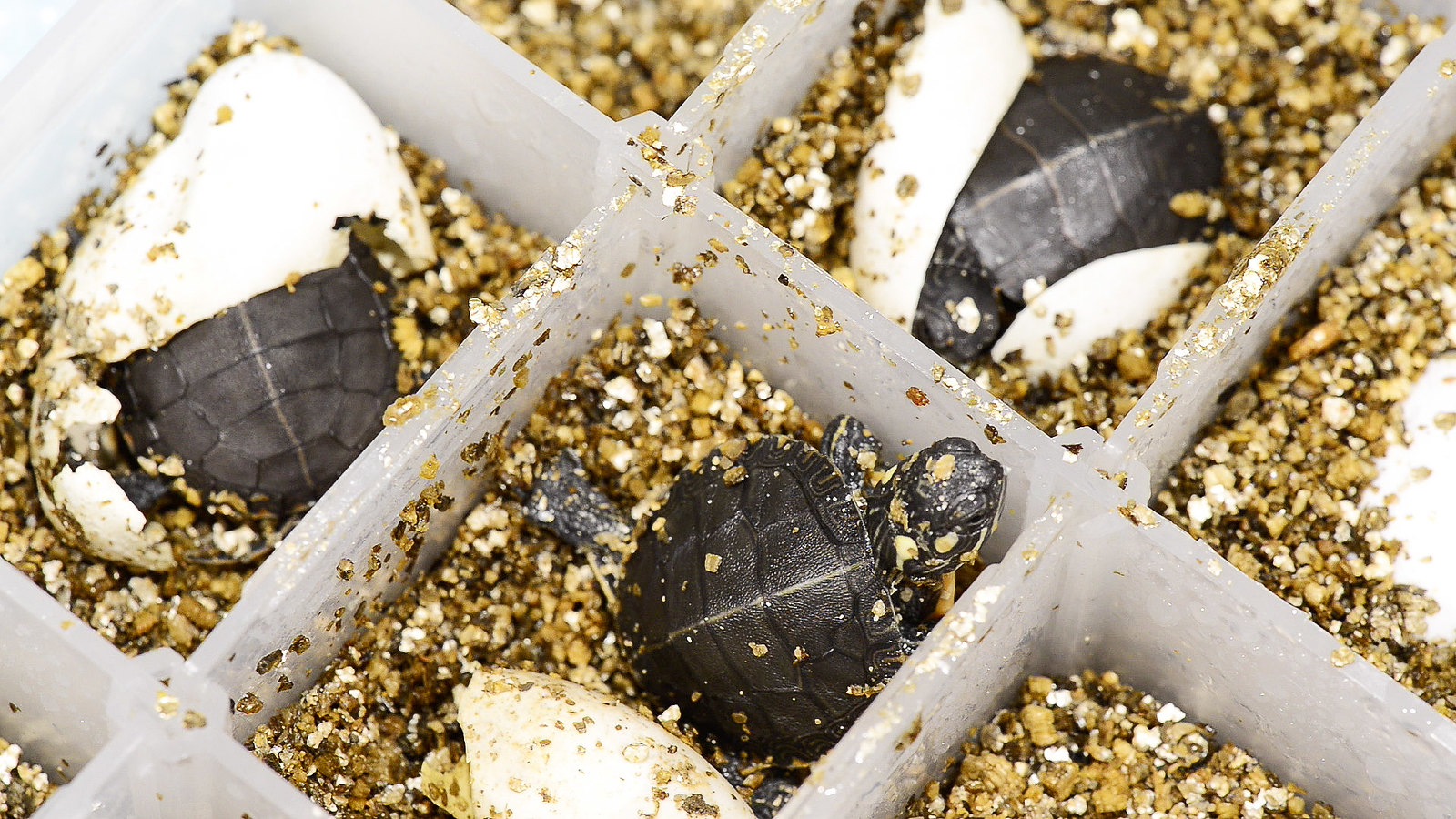By Jinghong Chen | Bond Life Sciences Center

Cool dudes, hot mommas. This is the underlying concept behind sex development in painted turtles, a species that lacks sex chromosomes.
A painted turtle’s sex is determined by temperature at which the eggs are incubated at critical stages during early development. Eggs incubated at lower temperatures produce male turtles, while those incubated at higher temperatures results in females.
However, early exposure to certain environmental chemicals that mimic hormones naturally produced in individuals can override incubation temperature. Scientists at the Bond Life Sciences Center have teamed up to study how endocrine disrupting chemicals (EDCs), namely bisphenol A (BPA) and ethinyl estradiol (EE), result in irreversible sexual programming of the brain in painted turtles.
“Turtles do not have sex chromosomes. Instead, they demonstrate temperature sex determination. But if they are exposed to EDCs prior to when certain organs form, such chemicals can cause partial to full sex reversal to female both in terms of the gonad and brain,” said Cheryl Rosenfeld, a Bond Life Sciences Center investigator and an associate professor of biomedical sciences at the University of Missouri. “The males will essentially act like females in terms of their behavioral responses.”
The hormones Rosenfeld refers to are BPA and EE, two widely used EDCs. BPA is present in many commonly used household, such as plastic food storage containers, store receipts, and dental fillings. The EE is present in birth control pills and can accumulate in many aquatic environments. These chemicals have been identified in all aquatic environments tested to date, including rivers and streams. Thus, exposure of turtles and other species that inhabit such environments can potentially lead to irreversible effects.
Previously, Rosenfeld and colleagues had studied how these chemicals change behavior of painted turtles after treating the eggs with BPA and EE under male-promoting temperatures. They discovered that male turtles that are early exposed to chemicals exhibit greater spatial navigational ability and improved memory, which are considered female-typical behaviors.
Rosenfeld and colleagues postulated that if the behavioral patterns differ between those exposed to BPA and those who were not, the different behaviors may be due to underlying and persistent differences in the neural circuitry between these two groups.

A gene map for turtle
In order to address this possibility, Rosenfeld teamed up with Scott Givan, associate director of the Informatics Research Core Facility, to study the gene expression profiles of the turtles and potentially identify patterns of gene expression associated with the altered behaviors.
After Rosenfeld’s team tested the behavior of the turtles, they collected RNA from the turtle brains to perform a technique called RNAseq that isolates all of the transcripts expressed in this organ. RNA is a nucleic acid that carries genetic information and is indicative of the expression level of every gene in the turtle genome. Once these sequencing results were obtained, Givan had to align the results to the painted turtle genome that has been previously sequenced and annotated. He then determined the transcripts that were differentially expressed in turtles developmentally exposed to BPA or EE versus those unexposed individuals.
There are no existing turtle gene pathway profiles. Therefore, Givan had to analyze the turtle gene expression profiles based on those previously identified in human samples.
“[One] of the most important things in this paper is the linkage of the gene expression profile to behavior difference,” Givan said. “But the gene and metabolic pathway data don’t exist for turtles. We had to basically infer pathway modeling based on the human metabolic pathway maps.”

The results suggest that BPA and, to a much lesser extent, EE exposure overridden incubation temperature and altered the gene expression profile in the brain to potentially reprogram brain to the female rather than male pathway. Specifically, BPA exposure was associated with metabolic pathway alterations involving mitochondria, such as oxidative phosphorylation and influenced ribosomal function.
Mitochondrial activity provides energy. Up-regulation of metabolic pathways in mitochondria can lead to more energy in brain cells, which may have permitted BPA-exposed turtles to demonstrate faster responses and greater cognitive flexibility, including enhanced spatial navigational ability that was previously identified in this group.
The other changes — oxidative phosphorylation and ribosomal function — play key roles in protein synthesis. Specifically, oxidative phosphorylation generates is one of main pathways involved in generating ATP, which is considered an energy source. Ribosome functions to assemble amino acids together for the synthesis of proteins, including enzymes that may facilitate metabolic reactions.
Less appealing males
The possibility for shifting brain sex has a real impact in the wild.
In the beginning, a turtle’s brain is neutral, as it is requires hormones to sculpt and direct it to be male or female. However EDCs, such as BPA and EE, can usurp these normal pathways and cause the brain of otherwise male turtles to develop more feminine characteristics.
“There are certain programmed behaviors [male turtles] have to do to entice the female to select them as their reproductive partner, but if he is not demonstrating these male-typical behaviors, she will likely reject him,” Rosenfeld said. “Even if such chemicals reprogram the brain and subsequent adult behaviors without affecting the gonad, it could have individual and population consequences by reducing a male’s likelihood of breeding.”
Combined with possible shrinking and already inbred population, declines in male turtles or skewing of sex ratio to females that could originate due to EDC-exposure, could push turtle species that exhibit temperature-dependent sex determination (TSD) to the brink of extinction.
“The concern also with turtle species that exhibit TSD, climate change and exposure to EDCs can lead to detrimental and irreversible imbalances in sex ratio favoring females over males, and thereby compromising genetic diversity of the population as a whole,” Rosenfeld said.
Future studies in Rosenfeld’s lab plan to extend the research to female turtles to learn whether the chemicals have any effects on females derived based on TSD rather than those due to exposure to environmental chemicals that are similar to estrogen. She also hopes to look into individual brain regions, such as the forebrain and hippocampus that are essential for cognitive abilities.
Cheryl Rosenfeld is a Bond LSC investigator,associate professor of biomedical sciences, and research faculty member in the Thompson Center for Autism and Neurobehavioral Disorders. Scott Givan is the associate director of Informatics Research Core Facility and research assistant professor of molecular microbiology and immunology.
This research was funded by the Mizzou Advantage Program, the Bond Life Sciences Center and the University of Missouri Office of Research.

